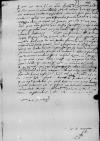Letter #1926
Ioannes DANTISCUS to Tiedemann GIESEHeilsberg (Lidzbark Warmiński), 1538-09-20
English register:
Dantiscus impatiently awaits the tailor’s return, and asks Giese to intervene. He asks what time of day Giese will arrive in Guttstadt (Dobre Miasto).
Letters from the royal court have arrived. Dantiscus is surprised that Duke [Albrecht I Hohenzollern-Ansbach] was a mediator in their delivery. The servant Dantiscus sent to Cracow [Filip Szczepanowski] stopped there because of the death of his father [Erazm Szczepanowski]. The other messenger [Mauritius] should be back soon.
Dantiscus is sending Giese a letter received from [Samuel] Maciejowski and a letter [of Georg Hegel?] regarding the conduct of the Fuggers’ servant [Vincentz Walch]. Dantiscus is also passing on a letter to Giese from the Queen [Bona Sforza]. He expects the King’s [Sigismundus I Jagiellon’s] letter on public matters soon.
| received 1538-09-21 Manuscript sources:
Prints:
| ||||||
Text & apparatus & commentary Plain text Text & commentary Text & apparatus
Reverendissimo Domino
Reverendissime mi Domine, frater et amice carissime et honoran(de) or honoran(dissime)⌈honoran(de)honoran(de) or honoran(dissime)⌉.
Salutem et fraterni amoris commendationem.
Hunc
Misit mihi paulo ante
ill(ustrissimus) or ill(ustris)⌈ill(ustrissimus)ill(ustrissimus) or ill(ustris)⌉ dominus
Quae mihi scripsit dominus decanus Cracoviensis
Interim Dominatio Vestra Reverendissima, cuius adventum magna cum alacritate desidero, felicissime valeat.
Ex
Reverendissimae Dominationis Vestrae frater integerrimus


 BCz, 245, p. 74
BCz, 245, p. 74